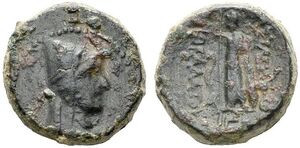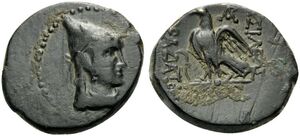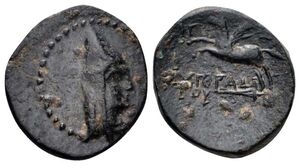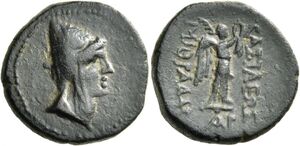Mithradates II c.36-20 BC (Kov 230-235)
Description
Mithradates (BNP [17]), son of Antiochus I, was probably confirmed as king in Antony's reorganization of the client kingdoms of Asia Minor and Syria, and was allowed to retain his crown by Octavian. Around 29 BC Mithradates survived an attempt to unseat him by his brother Antiochus, who was subsequently executed.
The coins listed below have been previously assigned to Mithradates I Callinicus, although there are two compelling reasons to doubt that attribution: 1) the absence of the name "Callinicus" on coins nos. 230-235, and 2) the difference in style from those below. The reason for reattributing these coins to Mithradates II of Commagene instead of some other Mithradates is the coincidence of mint marks at Laodicea (Syria), a plausible mint for Mithradates in this period. In the first case the mint mark ΙΓ is actually a Julian date which appears on two civic issues (RPC 4406 and 4421) and converts to 35/34 BC, approximately the expected first year of Mithradates's reign (ca. 36 BC). The other mint mark AP is that of a monetary magistrate and appears on four dated civic issues of Laodicea (RPC 4388 4390, 4433, and 4434). The dates, from 25/24 to 20/19 BC, fall into the last five years of the reign of Mithradates II.
There are four denominations in this reign: the eight chalkoi with Apollo reverse is an exceptional denomination, and has been listed in the first emission even though the poor quality of the sole surviving example reveals no date or mint mark. The four chalkoi occurs with an Athena reverse; the two chalkoi with two different reverse types, Nike, and eagle on thunderbolt; and the chalkous, also with two reverse types, Pegasus and club. On two of the types (Athena and eagle on thunderbolt) there is a lituus in the left field, attesting to the involvement of an augur, perhaps Mark Antony himself.
Kovacs, Frank L. “Armenian Coinage in the Classical Period” CNS 10, Classical Numismatic Group, Lancaster, 2016, pp. 41.
The coins listed below have been previously assigned to Mithradates I Callinicus, although there are two compelling reasons to doubt that attribution: 1) the absence of the name "Callinicus" on coins nos. 230-235, and 2) the difference in style from those below. The reason for reattributing these coins to Mithradates II of Commagene instead of some other Mithradates is the coincidence of mint marks at Laodicea (Syria), a plausible mint for Mithradates in this period. In the first case the mint mark ΙΓ is actually a Julian date which appears on two civic issues (RPC 4406 and 4421) and converts to 35/34 BC, approximately the expected first year of Mithradates's reign (ca. 36 BC). The other mint mark AP is that of a monetary magistrate and appears on four dated civic issues of Laodicea (RPC 4388 4390, 4433, and 4434). The dates, from 25/24 to 20/19 BC, fall into the last five years of the reign of Mithradates II.
There are four denominations in this reign: the eight chalkoi with Apollo reverse is an exceptional denomination, and has been listed in the first emission even though the poor quality of the sole surviving example reveals no date or mint mark. The four chalkoi occurs with an Athena reverse; the two chalkoi with two different reverse types, Nike, and eagle on thunderbolt; and the chalkous, also with two reverse types, Pegasus and club. On two of the types (Athena and eagle on thunderbolt) there is a lituus in the left field, attesting to the involvement of an augur, perhaps Mark Antony himself.
Kovacs, Frank L. “Armenian Coinage in the Classical Period” CNS 10, Classical Numismatic Group, Lancaster, 2016, pp. 41.






